
Catalog excerpts

OHMMAT NANO, a simple and cost effective way to convert a composite in a heater. The best of composite and silicone rubber worlds bonded by the strength of Nanotechnology. Composites Nobody doubts nowadays about the great advantages of composites and their increasing demand in the last decades. What was only present in specially demanding technology applications like aerospace, appears to be today a promising alternative to materials used in different industrial sectors. Automotive industry is by far the largest market for composites. Weight reduction is the greatest advantage of composite materials usage. Composites are often the material of choice in corrosive environments like chemical processing plants. Fiber reinforced composites are also replacing many traditional materials for home and architectural components like doors, wall panels and frames. Composite materials offer windmills constructors strength and flexibility through manufacturing processes with the added benefit of lightweight components. Industrial sectors like sport and recreation, marine, energy and finally, electronics, choose composites thanks to their arc and track resistance (1). Silicone rubber heaters SILICONE RUBBER is one of the preferred polymer materials to build a HEATER. The heating element consists of a resistive metal alloy with a defined resistivity, length and section, isolated by a silicone rubber. The heater is attached to the object to be heated. Generally speaking, the metal alloy may be a heating wire (figure 1) or a resistive printed circuit board (figure 2) obtained by chemical etching of metal-clad silicone rubber sheets to a defined layout depending on the final power and electrical resistance to be achieved. Figure 1: wire wound
Open the catalog to page 1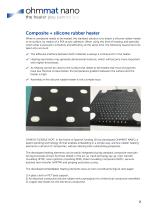
Composite + silicone rubber heater When a composite needs to be heated, the standard solution is to attach a silicone rubber heater to its surface, by means of a PSA acrylic adhesive. When using this kind of heating, and specially when what is pursued is simplicity and efficiency at the same time, the following issues has to be taken into account: The adhesive interface between both materials is always a critical point in the heater. Heating asymmetry may generate dimensional tensions, which will become more important with higher thicknesses. As heating cannot be close to the surface that...
Open the catalog to page 2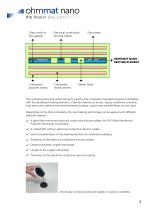
Glass cloth or pet support Electrical conductive silicone rubber HOHMMAT NANO HEATING ELEMENT Composite polymer matrix Composite renforcement Heater holes The usual polymers and reinforcements used for the composite manufacturing are compatible with the developed heating elements. Polymer matrixes as acrylic, epoxy, melamine, phenolic, vinyl ester and urethane and reinforcements as glass, carbon and aramide fibers can be used. Depending on the final composite, the new heating technology can be applied with different material supports: A glass fiber reinforced electrical conductive silicone...
Open the catalog to page 3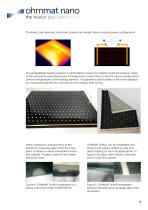
Thickness, filler densities, electrode distance and lenght allow a debsity power configuration. - The embeddable heating element is perforated to ensure its integrity inside the polymer matrix of the composite while keeping an homogeneous current flow across the silicone rubber and a uniform temperature of the heating element. The geometry and number of the holes depends on composite polymer resin and its intrinsic integrity after curing Holes distribution and geometry in the electrical conductive glass cloth are a key point to obtain a robust embedded composite material. Polymer matrix fix the...
Open the catalog to page 4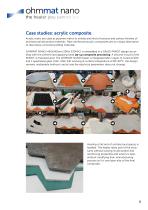
Case studies: acrylic composite Acrylic resins are used as polymer matrix to imitate any kind of textures and surface finishes of architectural decorative materials. Fiber reinforced acrylic composites are an unique alternative to decorative concrete building materials. OHMMAT NANO (450x540mm 200w 230VAC) is embedded in a GAUDI PANOT design according with the scheme and applying hand lay-up composite processing. A silicone mould of the PANOT is manufactured. The OHMMAT NANO heater is integrated after 1 layer of cured AC100 and 1 quadriaxial glass cloth. After 24h working at surface...
Open the catalog to page 5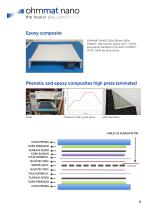
the heater you cannot see Epoxy composite OHMMAT NANO 150x200mm 100w 230VAC. IN2 infusion epoxy resin + AT30 slow epoxy hardener from EASY COMPOSITES. Hand lay processing. Phenolic and epoxy composites high press laminated Pressure 3 bar cycle press ohmmat nano
Open the catalog to page 6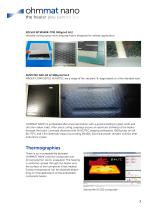
SOLVAY MTM348R-7781 300g/m2 HL2 versatile curing epoxy resin prepreg matrix designed for railway application. NUVOTEC 300-02 LZ 300g/m2 HL3 MÄDER COMPOSITES NUVOTEC are a range of fire-resistant. B-stage based on a fire retardant resin. OHMMAT NANO is embedded after press lamination with a good bonding to glass cloth and silicone rubber sides. After press curing, prepregs ensure an optimum bonding of the heater through the holes. Laminate obtained with NUVOTEC prepreg withstands 1000cycles on/off 60-70°C and 1,5m steel ball impact (according EN438). Electrical power remains to 115w after...
Open the catalog to page 7
Nuvotec composite Conclusions OHMMAT NANO heaters appear to be a feasible option to be integrated in a composite in a simple and cost effective way, without changing composite manufacturing process. Embedding them in acrylic and epoxy resins by hand lay process is feasible. OHMMAT NANO is also embeddable between B-stage phenolic and epoxy prepregs after press lamination with outstanding bonding properties. Bibliography 1. Introduction to composite materials. Tri-Dung Ngo (2020). 2. CDTI (Centro para el Desarrollo Técnico e Industrial). “Development of heating mats without resistive printed...
Open the catalog to page 8
